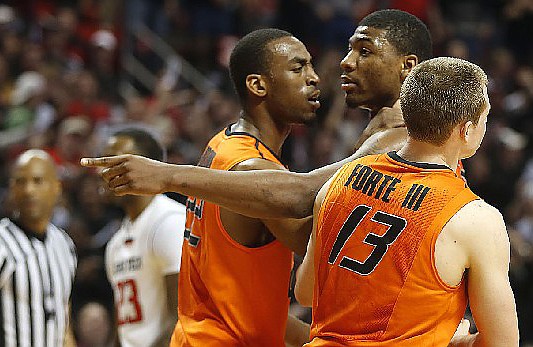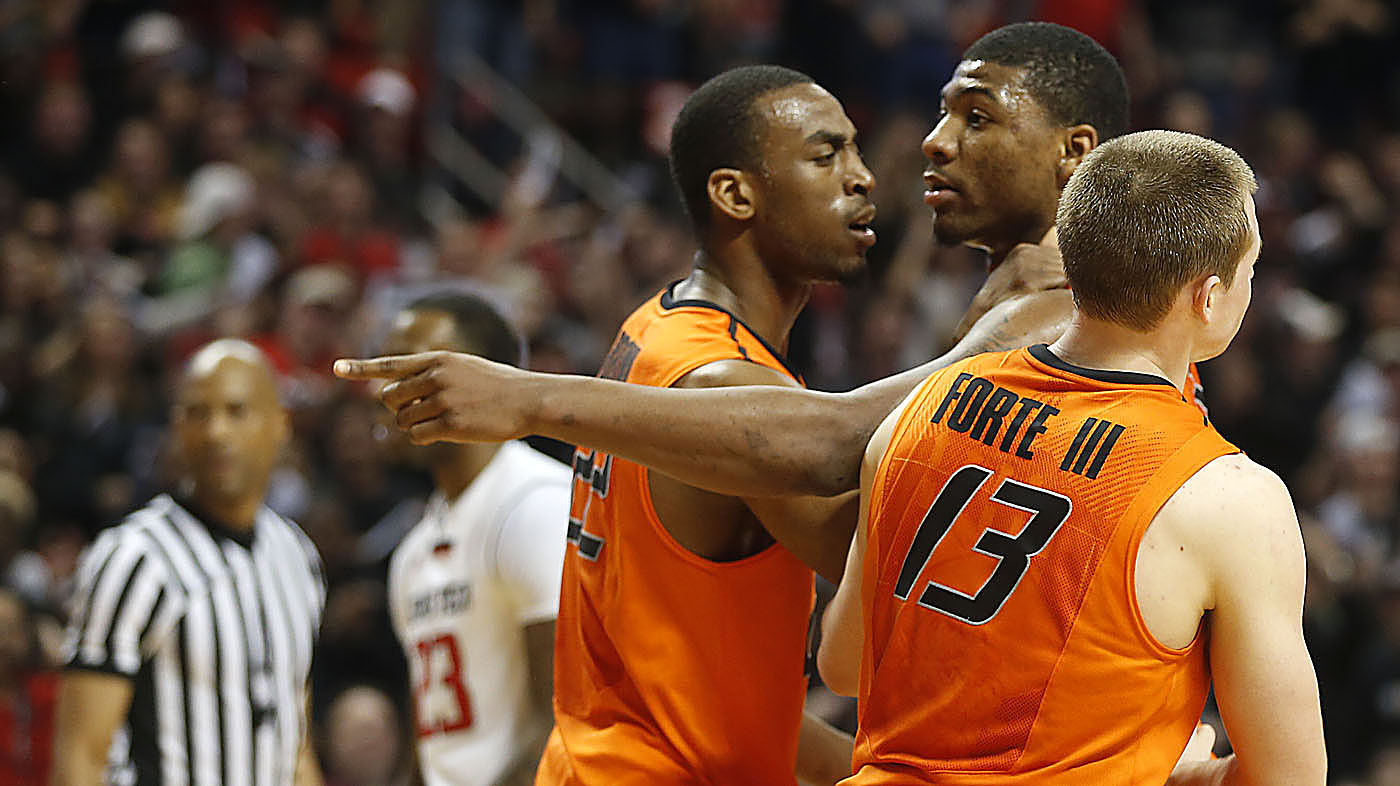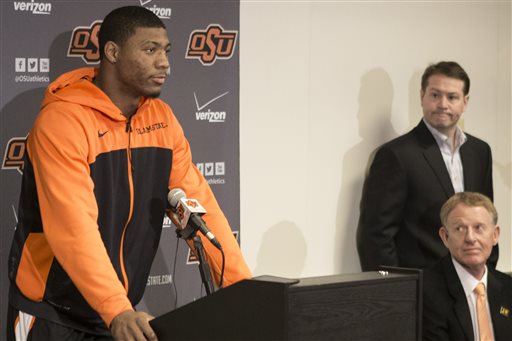Josh Deming understands Oklahoma State guard Marcus Smart's reaction to over-the-line fan
Tuesday, February 11, 2014
Watching the Marcus Smart situation unfold Saturday evening brought back some similar memories to Josh Deming. They weren't good ones, either.
Eyebrows were raised over the weekend when video footage showed Smart, a Oklahoma State sophomore guard, going after a fan late in the Cowboys' eventual 65-61 defeat at Texas Tech. After blocking a shot, Smart tumbled into the foot of the stands and then jumped up and pushed self-anointed Texas Tech "superfan" Jeff Orr. He said he heard Orr make a racist remark.
The potential first-round NBA draft pick was separated quickly from the situation.
Sunday evening, Smart was given a three-game suspension, while Orr - after saying he made a mistake but denying making racist statements - volunteered not to attend Texas Tech games the rest of this season. The conversation has turned toward the behavior of fans at games, as well as players in games at all levels.
It hit pretty close to home for Deming. Back on Nov. 11, 2004 - eight days before then-Indiana Pacer Ron Artest's infamous "Malice in the Palace" incident - Deming was part of a nasty situation when his Concordia College team from Selma, Ala., took on Faulkner University in an NAIA game in Montgomery.
Late in the first half, with his team falling behind, Deming - a 6-foot-6 forward who had been jawing back and forth with some Faulkner students throughout the game - started to feel pennies being thrown at him. He turned around and threw a water bottle at the students, which caused a number of them to come out of the stands, resulting in a riot that caused the eventual suspension of Deming from Concordia.
He now resides in Cleveland, Tenn.
"I was real close with my coach, and at the time his son was at a children's hospital, on the verge of death, so I had been dealing with a lot of stress," Deming said Monday. "Then I was frustrated with the game and it all hit me at once.
"I can take you saying stuff to me, but those pennies got to me. When you start throwing stuff, it's a different game."
He said the fight turned into about "20-25" people from Faulkner against the Concordia basketball team, and it lasted around 10 minutes. As the "instigator," he was the only one kicked out, and he spent the second half in the locker room as the hosts eventually won 86-72.
Deming said things got crazy on campus the next day. The incident had been featured on ESPN SportsCenter's "Not Top 10," which led to camera crews and newspapers from both Montgomery and Selma showing up on campus, wanting to interview him.
He declined.
"I just didn't want to deal with it," he said. "I didn't think it was a big deal, but I guess it was."
He feels that Smart's case is a prime example of some fans trying to "get famous." Spectators can say how they feel from the stands to players with no repercussions. Twitter has played a role, as the accessibility of players is a lot higher now and fans can communicate whatever thoughts they have without talking face-to-face with the players.
"As athletes, we're supposed to draw a line because we're entertainers, but a fan can say or do whatever he wants to do to rattle you. It's a one-way street," Deming said. "They can act crazy, but we're expected to maintain composure, and it's tough.
"I just think fans need to be held to some sort of standard, too."
University of Tennessee at Chattanooga senior forward Z. Mason has heard his share of hatred from opposing fan bases. He says it fuels him to play even better.
"When I first saw [the Smart incident], I wondered what the fan could have said to get him that upset," Mason said Monday evening. "At the same time, though, no matter what was said, you have to get past it and think about the next play. I can think back to the Davidson game - and the crowd is into it there - and they said things that you try not to pay attention to because it's part of basketball.
"It's actually fun to me."
It hasn't always been fun for some area high school coaches, though. In the past few seasons, there have been a couple of incidents locally in which players tussled with fans. In 2008, two Soddy-Daisy players were ejected for going into the stands to get involved in an altercation between parents. Eight players were kicked off the Hixson basketball team in 2011 for leaving the court during a game against East Hamilton.
"I think basketball is unique in that it's the closest to the action without separation," East Hamilton coach Michael Stone said. "As a coach, you don't really fear it: You talk briefly to the kids and tell them that if there's a fight, don't leave the bench. Plus we have the TSSAA, who I think has done a good job of telling officials to remove fans so that there are no personal attacks on players.
"The good thing about high school is that I think fans still see the players as kids, as opposed to in college where they see them as grown men, and it's more socially acceptable to berate a man than a kid."
Social media outlets, such as Twitter and Facebook, along with message boards and call-in shows - where most people can speak anonymously and without any sort of reprisal - have increased the level of access to players and coaches. People don't have to attach their names to what they are saying anymore, and that's provided a heightened level of boldness and sense of accomplishment when they attract reactions.
So is there a point in which their actions are out of bounds?
"I think that the fans, more and more, are of the opinion that they can say whatever they want without regard and without ramification," Vanderbilt coach Kevin Stallings said. "At times you can do so anonymously, whether it's on talk radio or on the Internet, and then you get into a public setting and there may be some carryover."
Even in a football-driven league like the Southeastern Conference, there still are passionate basketball fan bases. There are also a number of smaller SEC gymnasiums where fans are mere feet away from the athletes, so there's a great chance that what is being said is easily heard by a player.
Visiting coaches have to prepare their players for that barrage.
"There is going to be talk at every opposing arena toward your players," Ole Miss coach Andy Kennedy said. "That comes with the territory, and you have to prepare your guys the best you can. What was unfortunate in the Marcus Smart situation was that he found himself in the stands trying to make a play on the ball, and I think that certainly escalated the situation."
Tennessee coach Cuonzo Martin said Monday that the message for his team is clear: Be above the people who heckle you. No matter how hard it may be.
"I just think in Marcus's case it's unfortunate, because I've seen him from afar as a high school player - a very talented player with a lot of energy and a lot of emotion," Martin said. "It's sad, but you've got to keep moving forward. I'll tell our guys all the time: You have to be a professional in that situation and walk away. I know you're 18, 19, 20, 21 years old and you think you're an adult, but just walk away from that.
"When you're talking about a professional athlete who gets paid to do that, it's something different, but I think when you're talking about an amateur athlete, I think as fans we have to have a little restraint in certain situations, because they are kids.
"Here's a young man who probably felt like his team wasn't playing at the level he wanted them to play at, so things happen, and you say things as a young guy, you do things. It doesn't make him a bad person. It's just an incident, but again, I do think there is a difference when you're talking about professional athletes and how you treat and talk to him."
Staff writers Patrick Brown and David Paschall contributed to this report.
Contact Gene Henley at ghenley@timesfreepress.com or 423-757-6311. Follow him at twitter.com/genehenleytfp.


